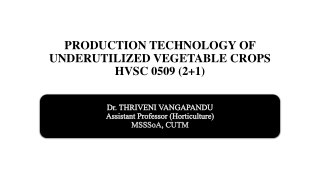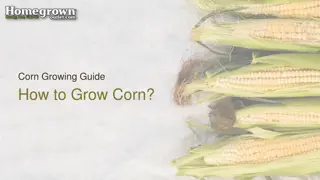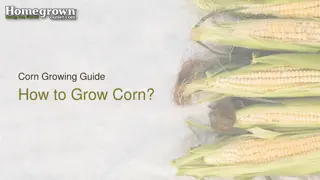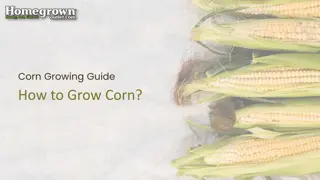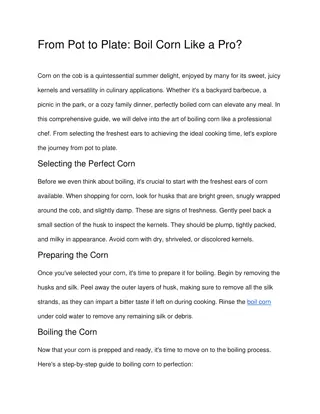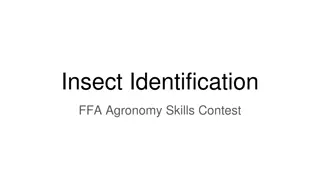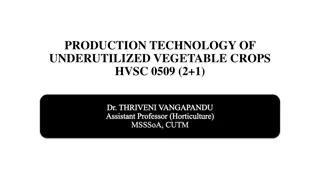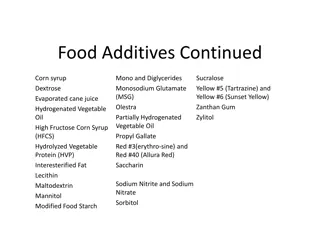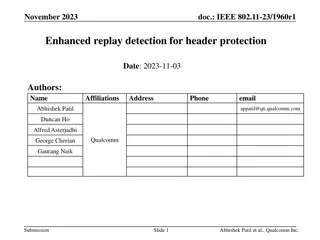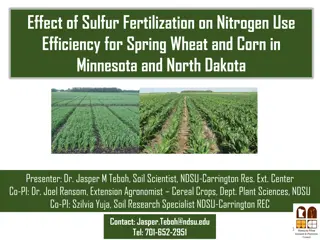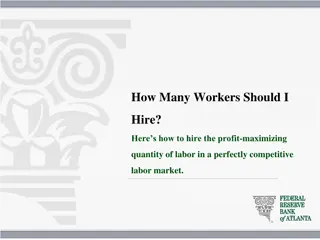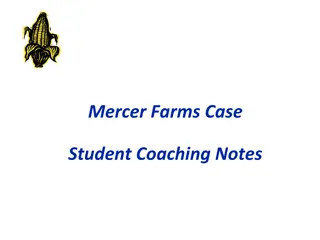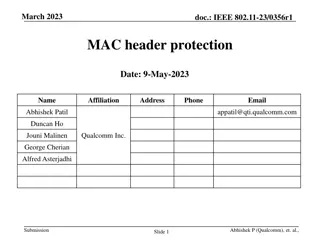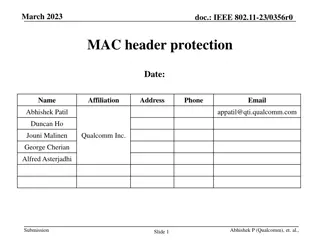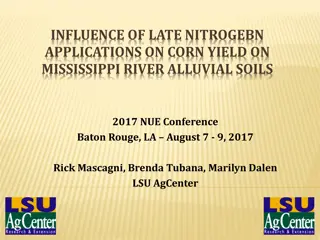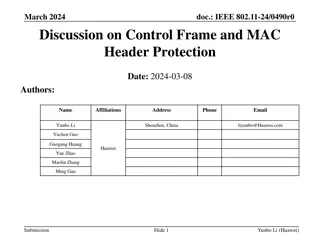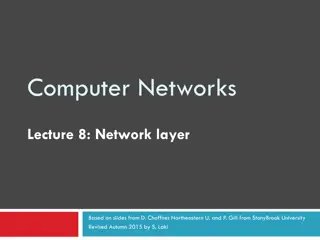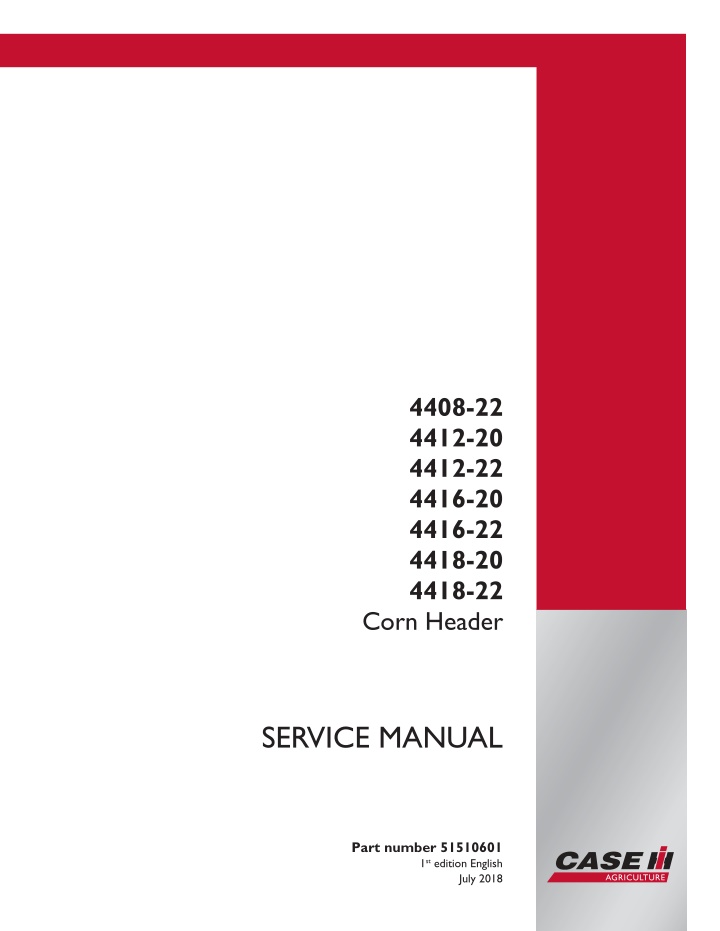
CASE IH 4408-22 Corn Header Service Repair Manual Instant Download
CASE IH 4408-22 Corn Header Service Repair Manual Instant Download
Download Presentation

Please find below an Image/Link to download the presentation.
The content on the website is provided AS IS for your information and personal use only. It may not be sold, licensed, or shared on other websites without obtaining consent from the author. If you encounter any issues during the download, it is possible that the publisher has removed the file from their server.
You are allowed to download the files provided on this website for personal or commercial use, subject to the condition that they are used lawfully. All files are the property of their respective owners.
The content on the website is provided AS IS for your information and personal use only. It may not be sold, licensed, or shared on other websites without obtaining consent from the author.
E N D
Presentation Transcript
4408-22 4412-20 4412-22 4416-20 4416-22 4418-20 4418-22 Corn Header SERVICE MANUAL Printed in U.S.A. Part number 51510601 1st edition English 2018 CNH Industrial America LLC. All Rights Reserved. Case IH is a trademark registered in the United States and many other countries, owned or licensed to CNH Industrial N.V., July 2018 its subsidiaries or affiliates.
SERVICE MANUAL 4408-22 Eight-row corn header with twenty-two inch row spacing., 4412-20 Twelve-row corn header with twenty inch row spacing., 4412-22 Twelve-row corn header with twenty-two inch row spacing., 4416-20 Sixteen-row corn header with twenty-inch row spacing., 4416-22 Sixteen-row corn header with twenty-two inch row spacing., 4418-20 Eighteen-row corn header with twenty inch row spacing., 4418-22 Eighteen-row corn header with twenty-two inch row spacing. 51510601 27/07/2018 EN
Contents INTRODUCTION Hydraulic systems....................................................................... 35 [35.000] Hydraulic systems.................................................................. 35.1 [35.603] Deck plate hydraulic system ....................................................... 35.2 [35.910] Head and header hydraulic drive .................................................. 35.3 Electrical systems....................................................................... 55 [55.000] Electrical system ................................................................... 55.1 [55.100] Harnesses and connectors......................................................... 55.2 [55.404] External lighting .................................................................... 55.3 [55.421] Feeding control system ............................................................ 55.4 [55.662] Header height control .............................................................. 55.5 [55.785] Precision farming system .......................................................... 55.6 [55.995] Chopper slip clutch monitoring system............................................. 55.7 Attachments/Headers.................................................................. 58 [58.100] Attachment/Header support and drives ............................................ 58.1 [58.120] Attachment/Header feed auger .................................................... 58.2 [58.130] Attachment/Header frame.......................................................... 58.3 [58.208] Corn header shields and guards ................................................... 58.4 [58.210] Corn header feed chain and rollers ................................................ 58.5 [58.218] Corn header feeder structure ...................................................... 58.6 [58.220] Corn header structure.............................................................. 58.7 [58.224] Header drive ....................................................................... 58.8 [58.228] Rotating dividers ................................................................... 58.9 [58.230] Stalk choppers ................................................................... 58.10 [58.414] Row-independent header gearboxes ............................................ 58.11 Lubrication system...................................................................... 71 51510601 27/07/2018
https://www.ebooklibonline.com Hello dear friend! Thank you very much for reading. Enter the link into your browser. The full manual is available for immediate download. https://www.ebooklibonline.com
[71.480] Oiler system........................................................................ 71.1 51510601 27/07/2018
INTRODUCTION 51510601 27/07/2018 1
INTRODUCTION Foreword - Important notice regarding equipment servicing All repair and maintenance work listed in this manual must be carried out only by qualified dealership personnel, strictly complying with the instructions given, and using, whenever possible, the special tools. Anyone who performs repair and maintenance operations without complying with the procedures provided herein shall be responsible for any subsequent damages. The manufacturer and all the organizations of its distribution chain, including - without limitation - national, regional, or local dealers, reject any responsibility for damages caused by parts and/or components not approved by the manu- facturer, including those used for the servicing or repair of the product manufactured or marketed by the manufacturer. In any case, no warranty is given or attributed on the product manufactured or marketed by the manufacturer in case of damages caused by parts and/or components not approved by the manufacturer. The manufacturer reserves the right to make improvements in design and changes in specifications at any time without notice and without incurring any obligation to install them on units previously sold. Specifications, descriptions, and illustrative material herein are as accurate as known at time of publication but are subject to change without notice. In case of questions, refer to your CASE IH Sales and Service Networks. 51510601 27/07/2018 3
INTRODUCTION Personal safety Your machine may be equipped with special guarding or other devices in compliance with local legislation. Some of these require active use by the operator. Therefore, check local legislation on the usage of this machine. Hydraulic system safety Hydraulic oil leaking under pressure can penetrate the skin and cause infection or other injury. To prevent personal injury: Relieve all pressure before disconnecting fluid lines. Before applying pressure, make sure all connections are tight and components are in good condition. Never use your hand to check for suspected leaks under pressure. Use a piece of cardboard or wood for this purpose. If injured by leaking fluid, seek medical attention immediately. The hydraulic hoses and fittings on your machine meet engineering specifications for the particular function. When replacing damaged, blown or worn hoses or fittings, use only manufacture authorized service parts. Care in hydraulic hose installation is a must: Make sure pressure is relieved before starting installation procedure. DO NOT kink or twist a hose, failure may occur. Properly route the hose. Have a certified hydraulic technician install the hose. Remove air from the hydraulic system after installing any hydraulic component. Periodically check hydraulic system for leaks or damage. check for: Leaks at hose fitting or in hose. Damaged hoses and/or fittings. Kinked, crushed, flattened, hard blistered, heat cracked, charred, twisted, soft or loose covered hoses. Corroded or damaged fittings. Leaking ports. Excessive dirt and debris around hoses and/or fittings. Damaged or missing hose retaining clamps, guards, shields, etc. DO NOT stand on or use a hose as a step. DO NOT pull or apply external forces to the hose. The hose may fail and cause injury. Keep all persons away from the working area. Mechanisms controlled by fluid power can become hazardous if a hose fails. Lifted mechanisms can fall to the ground, machine steering may fail, etc. Stay clear of a pressurized hose assembly that has blown apart. Hose fittings can be thrown off at high speed and a loose hose can whip around with great force. Hydraulic fluid can reach high temperatures. Allow fluid to cool before servicing the system. Escaping fluid under pressure may form a mist or fine spray which can flash or explode upon contact with an ignition source. Vibration can reduce hose service life. Make sure all retaining clamps and/or devices are secured. Environmental conditions can cause hose and fittings to deteriorate. Inspect hydraulic hoses periodically. Replace worn or damaged hoses and fittings. Safety requirements for fluid power systems and components - hydraulics (EUROPEAN STANDARD PR EN 982) Flexible hose assemblies must not be constructed from hoses which have been previously used as part of a hose assembly. 51510601 27/07/2018 4
INTRODUCTION Do not weld hydraulic piping. When flexible hoses or piping are damaged, replace them immediately. It is forbidden to modify a hydraulic accumulator by machining, welding or any other means. Before removing hydraulic accumulators for servicing, the liquid pressure in the accumulator must be reduced to zero. Pressure check on hydraulic accumulators shall be carried out by method recommended by the accumulator man- ufacturer. Care must be taken not to exceed the maximum allowable pressure of the accumulator. After any check of adjust- ment there must be no leakage of gas. Safety precautions Farm accidents can be prevented with your help. No accident prevention program can be successful without the wholehearted cooperation of the person who is directly responsible for the operation of the equipment. To read accident reports from all over the country is to be convinced that a large number of accidents can be prevented only by the operator anticipating the result before the accident is caused and doing something about it. It is said that "The best kind of safety device is a careful operator who with care and mature consideration can save more lives and limbs than any accident prevention program which is not adhered to". Further in this chapter you will find a list of the most important safety precautions. Take time to read and follow the instructions and furthermore, be careful! Some pictures in this manual may show the safety guarding open or removed to better illustrate a particular feature or adjustment. Ensure to close or replace all guards before operating the machine. General and operating safety Most farm machinery accidents can be avoided by the observance of a few simple safety precautions. The machine must only be used by a skilled operator familiar with all the controls and harvesting techniques on cultivated land with slopes up to maximum 26% ( 15 ) uphill and downhill. Keep children away from and off the machine at all times. When driving on public roads, observe traffic regulations, adapt your speed to road and traffic conditions and ensure that all lights and other safety mechanisms on the machine (if they are required) are fitted and work properly. Before operating the machine ensure that all safety guards are installed. Do not enter the grain tank while the machine engine is running. With engine stopped, use a wooden clearing club should the grain tank unloading auger become bridged. Take utmost care not to be pulled into the grain tank in case unbridging is required. Do not attempt to clean, lubricate or carry out any adjustments on the machine while it is in motion or while the engine is running. Never leave the operator's platform without first disengaging the machine drive mechanism, lowering the header, stopping the engine, applying the park brake and removing the ignition key. Do not work under the machine header unless it is securely blocked and/or the header safety latch is engaged. Do not work around the machine in loose clothing that might catch in any of the moving parts. Keep hands away from moving parts of the machine. Keep the fire extinguisher within easy reach of the operator. Ensure to replace it by a similar type of extinguisher or have it checked or refilled after every usage and/or date of expiry. 51510601 27/07/2018 5
INTRODUCTION Danger of death by electrocution! Pay special attention to the overhead power lines. Make sure the machine has sufficient clearance to pass in all directions (also with raised or opened machine components). Also think of the radio aerial(s) or any other factory- fitted accessory or parts which may have been added afterwards. Should a contact between the machine and an electric power line occur, then the following precautions must be taken: Stop the machine movement immediately, stop the engine and apply the hand brake. Check if you can safely leave the cab or your actual position without direct contact with electric wires. If not, stay in your position and call for help. If you can leave your position without touching the lines, jump off the last step or support position to ensure that there is no contact between any part of your body and the ground at any time. Do not touch the machine afterwards until power to the lines has been shut off. When people approach the machine, warn them not to touch the machine but to ask the electric power supply company to shut off the power to the lines. Fire and explosion prevention Due to the flammable nature of the crop materials encountered, fire risks are high. This risk can be minimized by frequent removal of accumulated crop material from the machine and checking for overheated machine compo- nents. If oil leaks appear, re-torque bolts or replace gaskets as necessary. Remove all trash or debris from the machine each day. Especially check the engine area and exhaust system. Sparks or flame can cause the hydrogen gas in a battery to explode. To prevent an explosion do the following: Do not weld, grind or smoke near a battery. Sparks from the electrical system or engine exhaust can cause an explosion and fire. Before you operate this machine in an area with flammable dust or vapors, use good ventilation to remove the flammable dust or vapors. Use nonflammable cleaning solvent to clean parts. A fire can cause death or injury. Always have fire extinguisher near or on the machine. Make sure the fire extin- guishers are serviced according to the manufacturers instructions. If a fire extinguisher has been used, always recharge or replace the fire extinguisher before operating the machine. Make sure that you DO NOT store oily rags or other flammable materials on the machine. If the machine has an oil, fuel or hydraulic leak, always repair the leak and clean the area before operating. Check the electrical system for loose connections or frayed insulation. Repair or replace the loose or damaged parts. Before welding or using a torch on the machine, clean the area to be repaired. 51510601 27/07/2018 6
INTRODUCTION Safety rules Personal safety This is the safety alert symbol. It is used to alert you to potential personal injury hazards. Obey all safety messages that follow this symbol to avoid possible death or injury. Throughout this manual you will find the signal words DANGER, WARNING, and CAUTION followed by special in- structions. These precautions are intended for the personal safety of you and those working with you. Read and understand all the safety messages in this manual before you operate or service the machine. DANGER indicates a hazardous situation that, if not avoided, will result in death or serious injury. WARNING indicates a hazardous situation that, if not avoided, could result in death or serious injury. CAUTION indicates a hazardous situation that, if not avoided, could result in minor or moderate injury. FAILURE TO FOLLOW DANGER, WARNING, AND CAUTION MESSAGES COULD RESULT IN DEATH OR SERIOUS INJURY. Machine safety NOTICE: Notice indicates a situation that, if not avoided, could result in machine or property damage. Throughout this manual you will find the signal word Notice followed by special instructions to prevent machine or property damage. The word Notice is used to address practices not related to personal safety. Information NOTE: Note indicates additional information that clarifies steps, procedures, or other information in this manual. Throughout this manual you will find the word Note followed by additional information about a step, procedure, or other information in the manual. The word Note is not intended to address personal safety or property damage. 51510601 27/07/2018 7
INTRODUCTION Safety rules - Ecology and the environment Soil, air, and water quality is important for all industries and life in general. When legislation does not yet rule the treatment of some of the substances that advanced technology requires, sound judgment should govern the use and disposal of products of a chemical and petrochemical nature. Familiarize yourself with the relative legislation applicable to your country, and make sure that you understand this legislation. Where no legislation exists, obtain information from suppliers of oils, filters, batteries, fuels, anti-freeze, cleaning agents, etc., with regard to the effect of these substances on man and nature and how to safely store, use, and dispose of these substances. Helpful hints Avoid the use of cans or other inappropriate pressurized fuel delivery systems to fill tanks. Such delivery systems may cause considerable spillage. In general, avoid skin contact with all fuels, oils, acids, solvents, etc. Most of these products contain substances that may be harmful to your health. Modern oils contain additives. Do not burn contaminated fuels and or waste oils in ordinary heating systems. Avoid spillage when you drain fluids such as used engine coolant mixtures, engine oil, hydraulic fluid, brake fluid, etc. Do not mix drained brake fluids or fuels with lubricants. Store all drained fluids safely until you can dispose of the fluids in a proper way that complies with all local legislation and available resources. Do not allow coolant mixtures to get into the soil. Collect and dispose of coolant mixtures properly. The air-conditioning system contains gases that should not be released into the atmosphere. Consult an air-condi- tioning specialist or use a special extractor to recharge the system properly. Repair any leaks or defects in the engine cooling system or hydraulic system immediately. Do not increase the pressure in a pressurized circuit as this may lead to a component failure. Protect hoses during welding. Penetrating weld splatter may burn a hole or weaken hoses, allowing the loss of oils, coolant, etc. Battery recycling Batteries and electric accumulators contain several substances that can have a harmful effect on the environment if the batteries are not properly recycled after use. Improper disposal of batteries can contaminate the soil, groundwater, and waterways. CASE IH strongly recommends that you return all used batteries to a CASE IH dealer, who will dispose of the used batteries or recycle the used batteries properly. In some countries, this is a legal requirement. Mandatory battery recycling NOTE: The following requirements are mandatory in Brazil. Batteries are made of lead plates and a sulfuric acid solution. Because batteries contain heavy metals such as lead, CONAMA Resolution 401/2008 requires you to return all used batteries to the battery dealer when you replace any batteries. Do not dispose of batteries in your household garbage. Points of sale are obliged to: Accept the return of your used batteries Store the returned batteries in a suitable location Send the returned batteries to the battery manufacturer for recycling 51510601 27/07/2018 8
INTRODUCTION Safety signs Row Unit Drive and Chopper Drive Signs shown are for a corn header with a row unit drive system. The following safety signs are on your machine as a guide for your safety and for the safety of those working with you. Walk around the machine and note the content and the location of all safety signs before you operate your machine. Keep safety signs clean and legible. Clean safety signs with a soft cloth, water, and a gentle detergent. NOTICE: Do not use solvent, gasoline, or other harsh chemicals. Solvents, gasoline, and other harsh chemicals may damage or remove safety signs. Replace all safety signs that are damaged, missing, painted over, or illegible. If a safety sign is on a part you or your dealer replaces, make sure that you or your CASE IH CASE IHdealer install the safety sign on the new part. See your CASE IH dealer for replacement safety signs. Safety signs that display the Read Operator s Manual symbol are intended to direct the operator to the operator s manual for further information regarding maintenance, adjustments, or procedures for particular areas of the machine. When a safety sign displays this symbol, refer to the appropriate page of the operator s manual. Safety signs that display the Read service manual symbol direct you to the service manual. If you doubt your ability to perform service operations, contact your dealer. NOTE: Call outs on this page refer to decals as numbered on the following pages. 1 NHIL17MH00166AA Rear Non-chopping 51510601 27/07/2018 9
INTRODUCTION NOTE: Call outs on this page refer to decals as numbered on the following pages. 2 NHIL17MH00164AA Rear Chopping 3 4 NHIL16GH00061AA Left NHIL16GH00069AA Right 51510601 27/07/2018 10
INTRODUCTION NOTE: Call outs on this page refer to decals as numbered on the following pages. 5 NHIL17MH00038AA Front 6 NHIL17MH00150AA Top 51510601 27/07/2018 11
INTRODUCTION WARNING Overhead lifting hazard. Lift and handle heavy components using lifting equipment with appropriate lifting capacity. Ensure that units are supported by suitable slings and hooks. Ensure that no persons or pets are in the vicinity of the load being lifted. Failure to comply could result in death or serious injury. Quantity: 2 84593097 7 84593097 (1) Left-Hand (LH) side of the feeder house opening top beam. 8 NHIL17MH00167AA (1) Right-Hand (RH) side of the feeder house opening top beam. 9 NHIL17MH00159AA 51510601 27/07/2018 12
INTRODUCTION WARNING Slippery surface. Do not use the area of the top beam outboard of these safety signs as a step or platform. Failure to comply could result in death or serious injury. Quantity: 2 87026533 10 87026533_B (2) LH side of the feeder opening on top of the top beam. 11 NHIL13GH00420AA (2) RH side of the feeder opening on top of the top beam. 12 NHIL13GH00419AA 51510601 27/07/2018 13
INTRODUCTION WARNING Hidden knife. Flying debris. Stay clear of the machine while running. Failure to comply could result in death or serious injury. Quantity: 4 Only used on chopper equipped corn headers. 84586899 13 84586899 (3) LH side rear backsheet (Chopper equipped units only). 14 NHIL17MH00080AA (3) RH side rear backsheet (Chopper equipped units only). 15 NHIL17MH00081AA (3) On the RH outer hood. 16 NHIL16GH00069AA 51510601 27/07/2018 14
INTRODUCTION WARNING Hidden knife. Flying debris. Stay clear of the machine while running. Failure to comply could result in death or serious injury. Quantity: 4 Only used on chopper equipped corn headers. 84586899 13 84586899 (3) On the LH outer hood. 17 NHIL16GH00061AA 51510601 27/07/2018 15
Suggest: If the above button click is invalid. Please download this document first, and then click the above link to download the complete manual. Thank you so much for reading
INTRODUCTION DANGER Crush Hazard. Engage safety latch before working under machine. Failure to comply could result in death or serious injury. Quantity: 4 144380A1 18 144380A1 (4) LH inboard vertical post. 19 NHIL17MH00167AA (4) RH side inboard vertical post. 20 NHIL17MH00159AA (4) RH side of the front panel 21 NHIL17MH00044AA 51510601 27/07/2018 16
https://www.ebooklibonline.com Hello dear friend! Thank you very much for reading. Enter the link into your browser. The full manual is available for immediate download. https://www.ebooklibonline.com

